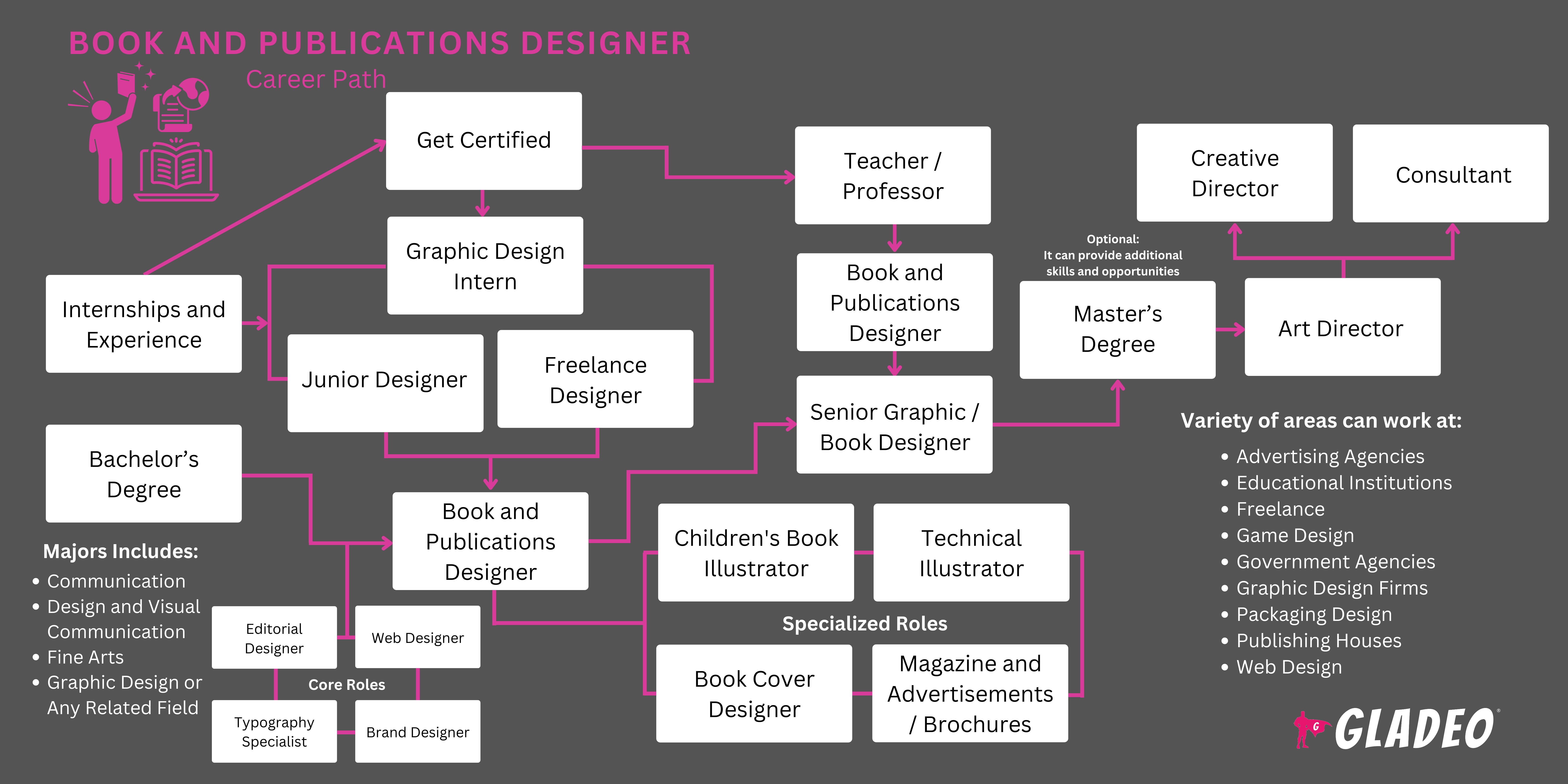Spotlights
Nghệ sĩ, Nhà thiết kế, Nghệ sĩ đồ họa, Nhà thiết kế đồ họa, Nhà sản xuất trực tuyến, Nghệ sĩ sản xuất, Nhà thiết kế ấn phẩm
When you’re browsing magazines or books, what makes you pick up one versus the other? Often, it’s the cover image that catches your eye and prompts you to check it out, right?
Those covers are carefully crafted by Book and Publication Designers responsible for the visual layout and design of books, magazines, and other printed materials. These graphic designers work closely with publishers to ensure images, typography, arrangement, and overall theme are harmonious, attention-getting, and relevant to the publication and target audience.
Balancing artistic creativity with technical precision, Book and Publication Designers play a crucial role in bringing written works to life–and boosting sales! They start with an initial concept (based on guidance the publisher gives them), then use design software to develop layout ideas to make the cover stand out.
They also need to be familiar with basic printing techniques, paper types, inks, and binding options. In addition, since many publications are entirely digital, they should consider what a cover will look like on a small screen like a phone or table.
- Having their work displayed on covers viewed by potentially millions of shoppers
- Gaining industry recognition while collaborating with other creative professionals
- Helping to increase product sales and promote the industry
Lịch làm việc
Book and Publication Designers usually work full-time. They may have to put in extra hours if a project deadline is fast approaching.
Nhiệm vụ tiêu biểu
- Discuss projects and design requirements with supervisors, project managers, or publishers
- Research target audiences to get a feel for what will resonate with them
- Select existing artwork or photography that fits the design concept
- Collaborate with artists or photographers to commission custom work
- Develop and design layouts for book covers, promotional materials, and other publications
- Select and combine fonts, colors, and images to create appealing designs
- Determine appropriate sizes and arrangements of elements, including text such as titles, subtitles, captions, author names, etc.
- Consider the formats that the final designs will be presented in (i.e., book covers, magazines, online, etc.) and the materials to be printed on (i.e., what type of paper and which types of ink will be used)
- Utilize digital illustration and photo editing software to make or manipulate graphical elements, logos, icons, and layouts
- Present design concepts, sketches, and mockups for review. Take notes and incorporate feedback for revisions. Keep track of changes
- Collaborate with other departments, as needed, such as marketing if designs need to be tied to advertising campaigns or other products
- Ensure final designs are error-free, adhere to brand guidelines, and have been approved before printing or publication
- Make sure designs are turned in on schedule and within budget
- Prepare digital files for printing. Provide any instructions to printer operators
Trách nhiệm bổ sung
- Experiment with different ideas and approaches
- Maintain an organized archive of previous designs, images, and project materials for reference
- Study competitors by reviewing their covers
- Keep up-to-date with industry trends and design software updates
- Ensure designs comply with copyright and usage laws
Kỹ năng mềm
- Chú ý đến chi tiết
- Kỹ năng giao tiếp
- Sáng tạo
- Good color vision
- Độc lập
- Động lực
- Kiên nhẫn
- Giải quyết vấn đề
- Quản lý thời gian
Kỹ năng kỹ thuật
- 3D design tools like Blender
- Ability to create digital and print layouts
- Color theory
- Design, layout, and photo editing software (e.g., Adobe InDesign, Photoshop, Illustrator)
- Digital illustration
- Pre-press and printing processes
- Printing materials (papers, inks, etc.)
- Thuật in máy
- Publishing houses
- Magazines and newspapers
- Marketing and advertising firms
- Freelance and contract work
The job of a Book and Publication Designer may seem straightforward, but it involves juggling a wide range of responsibilities. The quality of their work often determines whether a consumer takes notice of a book or magazine for sale.
Designers must consistently balance their artistic vision with client or employer expectations. Creative differences can arise, leading to frustration and additional rounds of revisions. Therefore, flexibility and strong communication skills are crucial to ensuring satisfaction with the final product.
This role requires proficiency in design software, a solid grasp of layout principles, and a keen sense of what appeals to consumers. Designers must stay current with trends in the publications and genres they work with, whether it's creating covers for science fiction novels or automotive magazines.
While the job can be demanding, Book and Publication Designers typically find great satisfaction in seeing their designs published and featured on bookshelves, magazine racks, or online marketplaces like Amazon.
Digital tools like Adobe InDesign and Photoshop continue to make it easier for designers to experiment with different styles and create eye-catching covers. As more people read digital books and magazines, designers must consider how covers will look when shrunk to a tiny thumbnail on a phone or tablet. Bold and simple designs that stand out are becoming more important for this.
Additionally, there is a growing trend towards using vibrant colors and unique textures to create distinctive looks that capture attention in a crowded market. The integration of mixed media, such as combining photography with illustration, is also gaining traction, offering a fresh approach to cover design
Book and Publications Designers often grew up appreciating art and maybe enjoyed drawing, painting, or graphic design.
- There are no mandatory educational requirements for Book and Publication Designers
- According to O*Net, 65% of graphic designers hold a bachelor’s degree
- Common degree majors include graphic design and fine arts
- Popular college courses include:
- Adobe Creative Suite (Photoshop, Illustrator, InDesign)
- Art History
- Color Theory
- Digital Illustration
- Graphic Design Principles
- Thiết kế layout
- Marketing and Branding
- Printing Processes and Materials
- Thuật in máy
- Designers can benefit from workshops to refine their skills and keep up with trends and tools
- Course delivery platforms like Class Central, Udemy, and others offer standalone courses at low prices
- Optional certifications and continuous learning are also important, such as:
- Adobe Certified Associate - InDesign
- Adobe Certified Associate - Illustrator
- Adobe Certified Associate - Photoshop
- Many students look for graphic design programs affiliated with the National Association of Schools of Art and Design, which counts hundreds of accredited institutions as members of its organization. These include art schools, conservatories, colleges, and universities.
- Programs should have experienced faculty, well-equipped studios, and opportunities for internships.
- Hãy cân nhắc đến chi phí học phí, các khoản giảm giá và cơ hội học bổng địa phương (ngoài viện trợ của liên bang).
- Think about your schedule and flexibility when deciding whether to enroll in an on-campus, online, or hybrid program.
- Review details about the program’s alumni network and how successful alumni have been in their careers.
- Take courses in art, graphic design, art history, and photography
- Join art and yearbook clubs at school
- Volunteer or take part-time jobs to work on local publications
- Play around with free versions of software like Canva to get practice
- Build a portfolio of your work to share with future employers
- Try freelancing to earn money while gaining experience with paying clients. Many self-published authors out there work with freelance designers
- Consider specializing in a particular niche and try to grow your network. Notice the different elements and styles for different genres
- Study books, articles, and video tutorials related to book and magazine publishing
- Find some book and magazine cover designs you like and try to replicate or improve upon them
- Read about successful book cover designers such as Anne Twomey and Nicole Caputo
- Practice creating multiple versions of a design then ask for feedback from peers
- Apply for apprenticeships or seek a mentor who can guide you
- Join online forums to get to know authors, editors, publishers, and graphic designers

- Use job portals like Indeed to find work and internship opportunities
- Visit the career pages of book and magazine publishing houses to see if they have openings. If you don’t yet have the experience desired by big publishers like Penguin Random House, HarperCollins, and Simon & Schuster, then give small independent publishers a try!
- Pay attention to the listed job requirements and keywords. Try to work relevant keywords into your resume, such as:
- Adobe Creative Suite
- Book Cover Design
- Branding
- Color Theory
- Composition
- Digital Art
- Thiết kế đồ họa
- Tác giả
- TrongThiết kế
- Thiết kế layout
- Mockups
- Máy ảnh Photoshop
- Pre-press Production
- Thiết kế in ấn
- Thuật in máy
- Check out Book Designer resume templates for ideas
- Review Book Designer interview questions to prepare ahead of time
- Prepare a strong portfolio and resume to highlight your skills and experience
- Use your college’s career services for job search assistance, resume writing, and mock interviewing. See if the program has any local industry connections
- Ask people in your professional network if they have any job tips
- Try freelancing. Build a solid reputation on sites like Upwork and build good relationships with self-published authors
- Consider creating a hard copy portfolio with high-quality prints of your work. Take this with you to job fairs along with business cards and copies of your resume
- Ask your professors, supervisors, and peers if they’ll serve as personal references. Don’t give out their contact information without asking first
- Always meet deadlines and deliver work within the agreed-upon budget
- Talk to your supervisor about things you can do to qualify for advancement such as taking extra courses or learning a new software program
- Ask about any sales data analysis that shows which covers are performing better, to look for patterns such as color schemes, fonts, or imagery
- See if there is any available retailer feedback or insights about which designs sell more
- Consistently deliver innovative, creative, high-quality covers that get attention and boost sales
- Network with other industry professionals to promote yourself and grow your reputation
- Forge strong relationships with publishers and be easy to work with
- Diversify your techniques by experimenting with different mediums, styles, and approaches
- Develop a cohesive body of work that defines your style and makes your cover designs recognizable
- Secure a mentor who can provide guidance, feedback, and insider knowledge about the industry
- Watch and learn from more experienced Book and Publication Designers
- Join professional organizations like the American Institute of Graphic Arts
Trang web
- 99Designs
- Viện Nghệ thuật Đồ họa Hoa Kỳ
- Behance
- Cover Design Studio
- Creative Bloq
- Người quan sát thiết kế
- Hiệp hội nghệ sĩ đồ họa
- Hiệp hội quốc gia các trường nghệ thuật và thiết kế
- PRINT Magazine
- Hiệp hội thiết kế đồ họa trải nghiệm
- Society of Illustrators
- Society of Publication Designers
- The BookDesigner
- Hiệp hội các nhà thiết kế đại học và cao đẳng
Sách vở
- Book Cover Designs, by Matthew Goodman and Nicole Caputo
- Rayguns and Rocketships: Vintage Science Fiction Book Cover Art, by Rian Hughes, Philip Harbottle, et al.
- The Look of the Book: Jackets, Covers, and Art at the Edges of Literature, by Peter Mendelsund and David J. Alworth
- Thinking with Type, by Ellen Lupton
Working as a Book and Publication Designer can be a creative and rewarding career, but it’s not always an easy one to break into. Many publishers keep designers on staff who stay there for years, limiting job opportunities.
The rise of self-publishing has opened more opportunities for freelancers, but thanks to the gig economy, there’s a lot of competition in the freelance world these days. If you’re looking for some alternative career options, consider some of the related fields below:
- Animator
- Architectural Illustrator
- Art Teacher
- Children’s Book Illustrator
- Quay phim
- Comic Artist
- Courtroom Sketch Artist
- Nhà thiết kế thời trang
- Thiết kế đồ họa
- Illustrator
- Nhà thiết kế công nghiệp
- Medical Illustrator
- Set Designer
- Special Effects Artist
- Nghệ sĩ kịch bản
- Tattoo Artist
- Technical Illustrator
- Nhà thiết kế trò chơi điện tử
Nguồn cấp tin tức

Việc làm nổi bật

Các khóa học và công cụ trực tuyến








